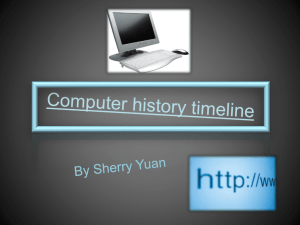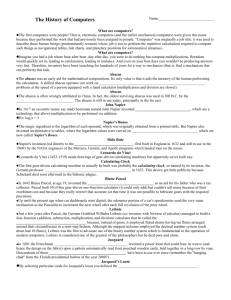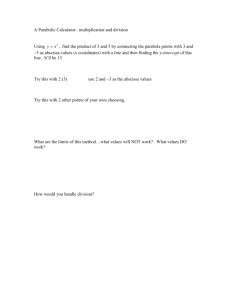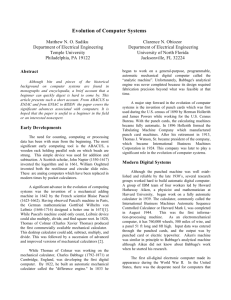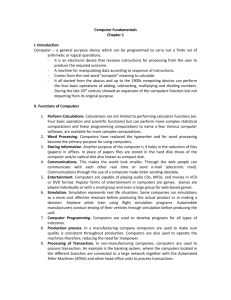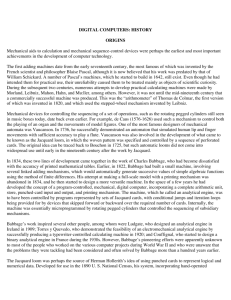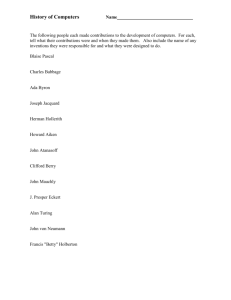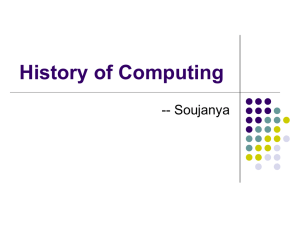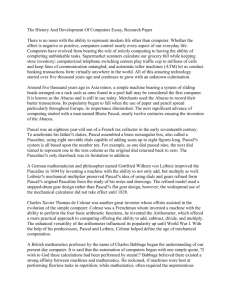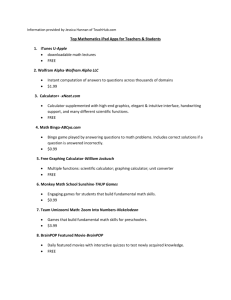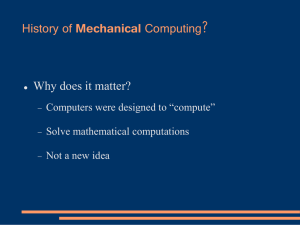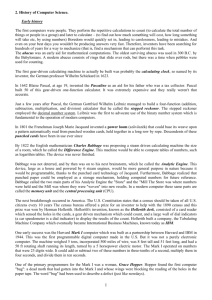History of Computers: From Abacus to ENIAC
advertisement
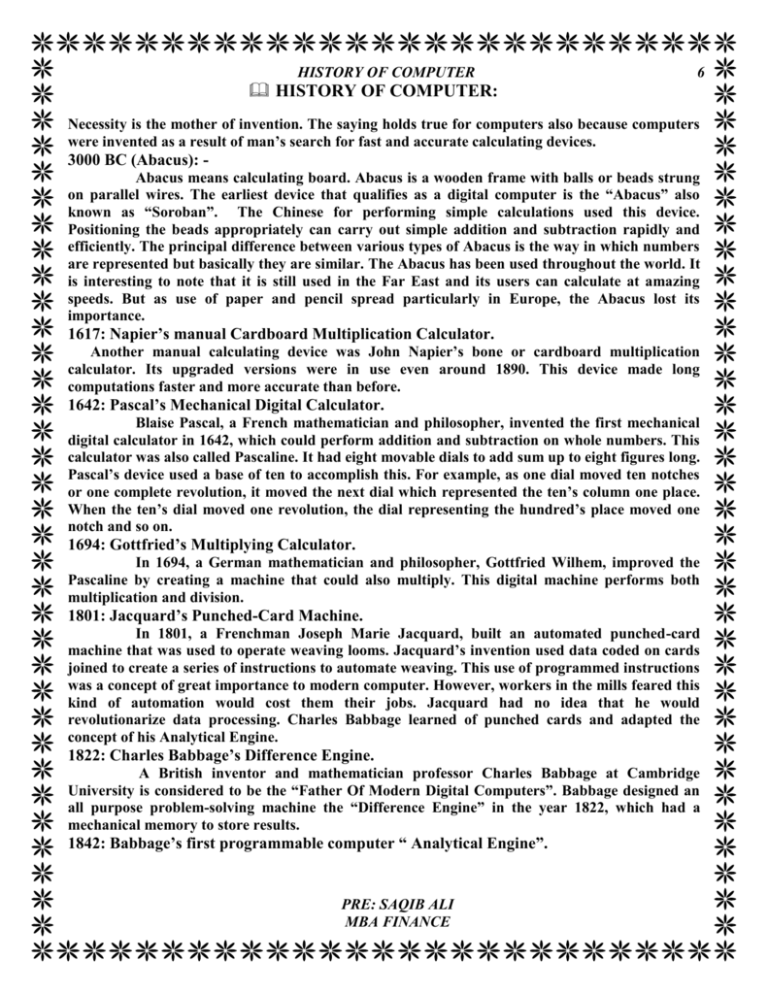
HISTORY OF COMPUTER 6 HISTORY OF COMPUTER: Necessity is the mother of invention. The saying holds true for computers also because computers were invented as a result of man’s search for fast and accurate calculating devices. 3000 BC (Abacus): Abacus means calculating board. Abacus is a wooden frame with balls or beads strung on parallel wires. The earliest device that qualifies as a digital computer is the “Abacus” also known as “Soroban”. The Chinese for performing simple calculations used this device. Positioning the beads appropriately can carry out simple addition and subtraction rapidly and efficiently. The principal difference between various types of Abacus is the way in which numbers are represented but basically they are similar. The Abacus has been used throughout the world. It is interesting to note that it is still used in the Far East and its users can calculate at amazing speeds. But as use of paper and pencil spread particularly in Europe, the Abacus lost its importance. 1617: Napier’s manual Cardboard Multiplication Calculator. Another manual calculating device was John Napier’s bone or cardboard multiplication calculator. Its upgraded versions were in use even around 1890. This device made long computations faster and more accurate than before. 1642: Pascal’s Mechanical Digital Calculator. Blaise Pascal, a French mathematician and philosopher, invented the first mechanical digital calculator in 1642, which could perform addition and subtraction on whole numbers. This calculator was also called Pascaline. It had eight movable dials to add sum up to eight figures long. Pascal’s device used a base of ten to accomplish this. For example, as one dial moved ten notches or one complete revolution, it moved the next dial which represented the ten’s column one place. When the ten’s dial moved one revolution, the dial representing the hundred’s place moved one notch and so on. 1694: Gottfried’s Multiplying Calculator. In 1694, a German mathematician and philosopher, Gottfried Wilhem, improved the Pascaline by creating a machine that could also multiply. This digital machine performs both multiplication and division. 1801: Jacquard’s Punched-Card Machine. In 1801, a Frenchman Joseph Marie Jacquard, built an automated punched-card machine that was used to operate weaving looms. Jacquard’s invention used data coded on cards joined to create a series of instructions to automate weaving. This use of programmed instructions was a concept of great importance to modern computer. However, workers in the mills feared this kind of automation would cost them their jobs. Jacquard had no idea that he would revolutionarize data processing. Charles Babbage learned of punched cards and adapted the concept of his Analytical Engine. 1822: Charles Babbage’s Difference Engine. A British inventor and mathematician professor Charles Babbage at Cambridge University is considered to be the “Father Of Modern Digital Computers”. Babbage designed an all purpose problem-solving machine the “Difference Engine” in the year 1822, which had a mechanical memory to store results. 1842: Babbage’s first programmable computer “ Analytical Engine”. PRE: SAQIB ALI MBA FINANCE HISTORY OF COMPUTER 7 In 1842, Babbage came out with his new idea of Analytical Engine that was intended to be completely automatic. It was capable of performing the basic arithmetical functions for any mathematical problem and it was to do so at an average speed of 60 additions per minute. It can perform calculations and printing mathematical table automatically using punch cards. He designed a system with an input section that would read holes, punched in cards. There were also provisions for printing answers and provided a control unit for operating the computer. Babbage also designed, but never built, an Analytical Engine that would have required half a dozen steam engines and would have taken up the space of a football field. He was unable to produce a working model of this machine mainly because the precision engineering required manufacturing his efforts established to the design of any digital computer. 1886: The American William Burroughs introduced the first commercially successful mechanical adding machine. 1890: American inventor Dr. Herman Hollerith developed the first Electro-Mechanical punched card data processing machine, which tabulated and sorted the data. This invention opened a gate to modern data processing. His tabulating machine company was one of the companies that later be came IBM (1924). 1930: Bush invented first Analog computer. (1937-1944): MARK 1 Computer. Haward A. Aiken, a mathematician of Harward University U.S.A. who wanted to build a general-purpose programmable computer that could calculate cannon shell trajectories. This device was similar to that which Babbage had proposed. In 1944 Aiken completed the first automatic sequence-controlled calculator, MARK 1. This was the first fully automatic calculating machine. It designed was based on the techniques already developed for punched card machinery. It was capable of performing five basic arithmetic operations: addition, subtraction, multiplication, division and table reference. A number about 23 decimal digits could be handle by this machine. It took approximately 0.3 second to add two numbers and 4.5 seconds for multiplication of two numbers. Hence the machine was very slow as compared to today’s computers. MARK 1 computer was abouth 3 feet wide, 4 feet tall and 6 feet long. The MARK 1 had no memory, so it did not remember any past event(s). This computer was only interested in current events. It used paper-tape input and punched card for output. With MARK 1, six months of manual calculation could be completed in one day. It was basically an electro-Mechanical device since both mechanical and electronic components were used. 1943-1946: ENIAC. The Electronic Numerical Integrator And Calculator (ENIAC) was the first electronic computer. It was constructed by J. Presper Eckert and John Mauchly. ENIAC was designed for the military need. It took up the wall spaced in a 20 X square feet room and used 18,000 vacuum tubes. It was 80 feet long and 18 feet high. The addition of two numbers was achieved in 200 microseconds, and multiplication in 2,000 microseconds. The ENIAC was not a particularly efficient general-purpose computer. Mauchly and Eckert claimed that ENIAC was the first general-purpose electronic digital computer. 1948: Transistor invented. PRE: SAQIB ALI MBA FINANCE HISTORY OF COMPUTER 8 1947-1949: EDSAC. An Englishman of U.S.A Maurice V.Wilkes of Cambridge developed EDSAC (Electronic Delay Storage Automatic Calculator), first stored program computer, completed. The machine executed its first program in May 1949. In this machine, addition operation was accomplished in 1500 microseconds, and multiplication operation in 4000 microseconds. 1946-1950: EDVAC. EDVAC (Electronic Discrete Variable Automatic Computer) another computer developed by The same people who had developed ENIAC. EDVAC was designed on stored program concept. Von Neumann has also got a share instructions and data in the binary form (a system that uses only two digits 0 and 1 to represent all characters) instead of the decimal numbers or human readable words. It consisted of five units that are Arithmetical, Central Control, Memory, Input and Output. 1951: UNIVAC. In 1951,The Universal Automatic Computer (UNIVAC) was the first digital commercial computer developed by Sperry Rand. It was commercially available digital computer that could be used for business, scientific applications and programming. It was not one of the kinds. Many UNIVAC machines were produced, the first of which was installed in the Census Bureau in 1951 and was used continuously for 10 years. The first business use of a computer, a UNIVAC 1, was by General Electric Corporation in 1954. The UNIVAC 1 was the first general purpose computer designed specially for business data-processing application. Previously computers had been used for scientific or military application. In 1952, the International Business Machines (IBM) Corporation introduced the 701 commercial computers. In rapid succession, improved models of the UNIVAC 1 and other 700 series machine were introduced. In 1953, IBM produced the IBM-650 and sold over 1000 of these computers. 1950-1953: Whirl Wind Computer. From 1950 to 1953, the US Navy and the digital computer lab at MIT (Massachusetts Institute of Technology) developed the Whirl Wind computer, another early vacuum-tube storedprogram computer. The Whirl Wind simulated high performance trainer air craft, contained self diagnostics and performs 50000 operations per second but it was only abouth 85 percent accurate. 1960: Mainframe computers were introduced in 1960s. 1964: Introduction of Integrated Circuits. 1965: Ken Olsen and his Digital Equipment Corporation (DEC) produce the first Minicomputer. 1970: Large Scale Integrated Circuits developed. 1975: Ed Roberts, who has been called the “father of the Microcomputer, developed First Microcomputer in 1975. 1980: CPU on a single chip. 1980’s: Super chip development. PRE: SAQIB ALI MBA FINANCE
